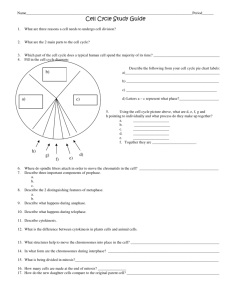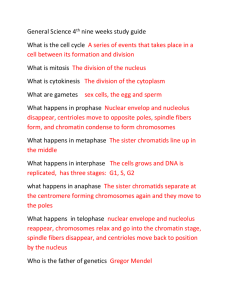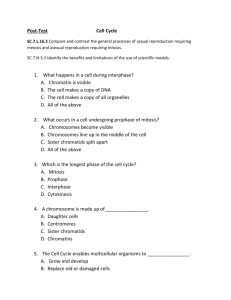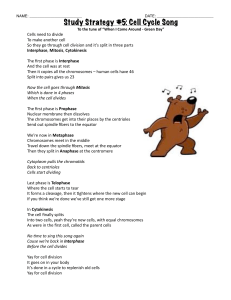SNC 2D Name: Unit: Tissues Date: The Cell Cycle When taken
advertisement
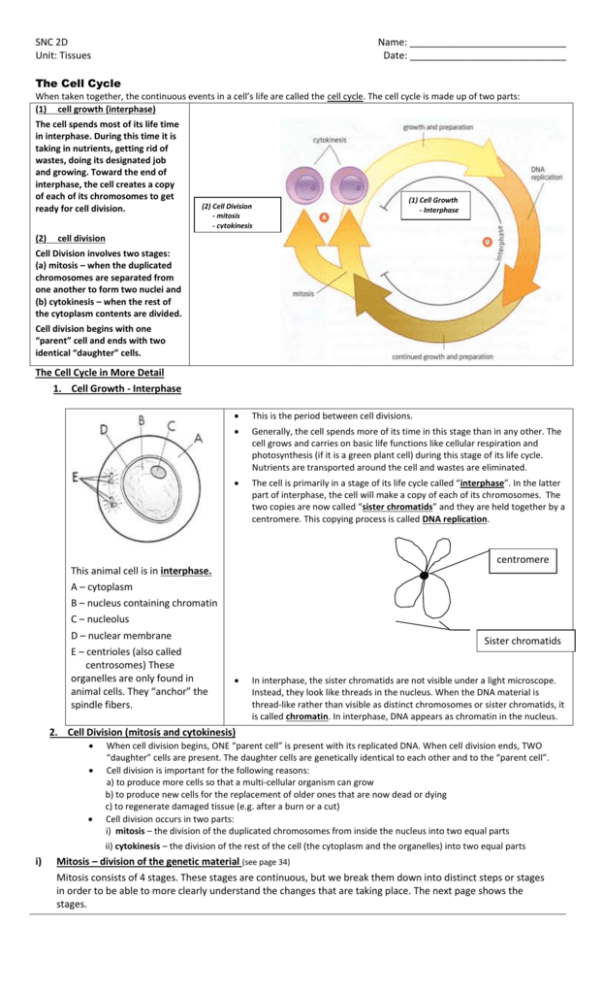
SNC 2D Unit: Tissues Name: _____________________________ Date: _____________________________ The Cell Cycle When taken together, the continuous events in a cell’s life are called the cell cycle. The cell cycle is made up of two parts: (1) cell growth (interphase) The cell spends most of its life time in interphase. During this time it is taking in nutrients, getting rid of wastes, doing its designated job and growing. Toward the end of interphase, the cell creates a copy of each of its chromosomes to get ready for cell division. (2) (2) Cell Division - mitosis - cytokinesis (1) Cell Growth - Interphase cell division Cell Division involves two stages: (a) mitosis – when the duplicated chromosomes are separated from one another to form two nuclei and (b) cytokinesis – when the rest of the cytoplasm contents are divided. Cell division begins with one “parent” cell and ends with two identical “daughter” cells. The Cell Cycle in More Detail 1. Cell Growth - Interphase This is the period between cell divisions. Generally, the cell spends more of its time in this stage than in any other. The cell grows and carries on basic life functions like cellular respiration and photosynthesis (if it is a green plant cell) during this stage of its life cycle. Nutrients are transported around the cell and wastes are eliminated. The cell is primarily in a stage of its life cycle called “interphase”. In the latter part of interphase, the cell will make a copy of each of its chromosomes. The two copies are now called “sister chromatids” and they are held together by a centromere. This copying process is called DNA replication. centromere This animal cell is in interphase. A – cytoplasm B – nucleus containing chromatin C – nucleolus D – nuclear membrane E – centrioles (also called centrosomes) These organelles are only found in animal cells. They “anchor” the spindle fibers. Sister chromatids In interphase, the sister chromatids are not visible under a light microscope. Instead, they look like threads in the nucleus. When the DNA material is thread-like rather than visible as distinct chromosomes or sister chromatids, it is called chromatin. In interphase, DNA appears as chromatin in the nucleus. 2. Cell Division (mitosis and cytokinesis) When cell division begins, ONE “parent cell” is present with its replicated DNA. When cell division ends, TWO “daughter” cells are present. The daughter cells are genetically identical to each other and to the “parent cell”. Cell division is important for the following reasons: a) to produce more cells so that a multi-cellular organism can grow b) to produce new cells for the replacement of older ones that are now dead or dying c) to regenerate damaged tissue (e.g. after a burn or a cut) Cell division occurs in two parts: i) mitosis – the division of the duplicated chromosomes from inside the nucleus into two equal parts ii) cytokinesis – the division of the rest of the cell (the cytoplasm and the organelles) into two equal parts i) Mitosis – division of the genetic material (see page 34) Mitosis consists of 4 stages. These stages are continuous, but we break them down into distinct steps or stages in order to be able to more clearly understand the changes that are taking place. The next page shows the stages. Stage 1 of Mitosis: Prophase Spindle fibres (F) Notice that the nuclear membrane is form between disappearing. centrioles (E) Early prophase Later prophase The chromosomes shorten and thicken. Remember that each piece of a replicated chromosomes is called a sister chromatid. Sister chromatids and are attached by the centromere. The sister chromatids “condense” or pull together so that now you can see them in a light microscope. In animal cells (only), the centrioles or centrosomes separate and move to opposite poles of the cell. They provide attachment for the spindle fibres, which serve as guides for the attachment of chromosomes during cell division. The nuclear membrane begins to fade. It dissolves to allow for separation of chromosomes and movement of cell organelles. Stage 2 of Mitosis: Metaphase The copied chromosomes, (sister chromatids) move toward the center of the cell, midway between the poles of the cell. Each chromosome attaches to a spindle fibre (H). Chromatids can become intertwined during metaphase. A – cytoplasm E – cenrioles G – sister chromatids lined up along the centre of the cell H – spindle fibers anchored at centrioles I – centromere holding together sister chromatids Stage 3 of Mitosis: Anaphase The centromeres holding the sister chromatids together, divide. The sister chromatids, which are now called single-stranded chromosomes (G2), move to opposite poles of the cell. The same number and type of chromosomes will be found at each pole of the cell. Stage 4 of Mitosis: Telophase The chromosomes reach the opposite poles of the cell and they begin to lengthen. The spindle fibres (H) dissolve. The nuclear membrane (D) begins to form around each mass of chromatin (G). ii) Cytokinesis – division of the rest of the cell Once the chromosomes have moved to opposite poles of the cell, the cytoplasm begins to divide. This often begins before telophase looks like it is over. In animal cells, a furrow develops, pinching the cell into two parts from the outside inwards. (See page 37.) In plant cells, the separation is accomplished by a cell plate that forms between the two new nuclei. The cell plate divides the material into two cells by growing from the inside outward. It develops into a new cell wall and seals off the contents of the new cells from each other. (See page 38.)



